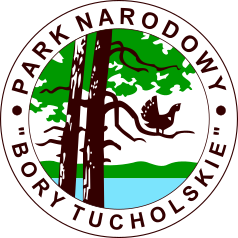Bory Tucholskie National Park
| Bory Tucholskie National Park | ||
|---|---|---|
|
|
||
| Location: | Pomerania , Poland | |
| Next city: | Charzykowy and Chojnice | |
| Surface: | 46.13 km² | |
| Founding: | 1996 | |
The National Park Bory Tucholskie ( Polish Park Narodowy Bory Tucholskie , German translated National Park Tucheler Heide ) is a national park in Poland .
General
It was founded in 1996. The national park is surrounded by the 340.26 km² nature reserve Zaborski (Zaborski Park Krajobrazowy). The park is located in the north-central part of Poland, in the Pomeranian Voivodeship . The core of the national park is the largest contiguous forest area in Poland after the Białowieża Primeval Forest (Puszcza Białowieska). This forest complex extends over an area of approximately 1170 km². The national park owes its name to these forests, the Bory Tucholskie (Tucheler Heide). Typical of this national park are large sand plains , which were created during the Ice Age under the influence of melt water. The sand areas are interrupted by numerous dunes, post-glacial gullies and valleys. The main goal of the national park is to protect this original sand landscape, which in this form is unique in Poland and Europe. There are over 20 lakes in the area of the national park, including some oligotrophic lakes with crystal clear water. In the middle of the valleys of the national park, which are characterized by high and steep banks, the rivers Brda (German Brahe) and Wda (German black water) flow , for which a particularly strong current gradient (up to 0.65% and 0.72 % achieved) and a relatively large number of narrow points are typical. In the national park you can also visit the longest aqueduct in Poland at Fojutowo and the oldest open-air museum in Poland at Wdzydze . In addition, the lakes and rivers of the national park offer ideal conditions for water sports. Since 1928 international canoe slaloms have been organized on the Brda, which, together with the Wda, is one of the most beautiful waterways in Poland . Also, the sailing will be actively pursued on the larger lakes.
flora
The park is mainly covered by pine forests. Of particular importance here are the water lobelia , the sea bream and the single-flowered strandling.
fauna
In addition to cranes , eagle owls , sea eagles , golden ducks and kingfishers, there are numerous other birds in the national park (144 bird species have been identified). The symbol of the national park is the capercaillie - a bird that was recently found in large numbers in the Bory Tucholskie, but is currently not found in the national park area. Also because the capercaillie is depicted on the national park's coat of arms, work is underway to reintroduce this chicken. The large mammals in the national park include deer , roe deer , wild boar , foxes , martens , otters and badgers . The abundance of bats in this area are exceptional , including the rough-skin bat , brown long-eared bat , mouse- eared bat , water bat and fringed bat . Of course there are also several species of fish in the lakes of the park, e.g. B. vendace , eel , perch , tench , bream and eel tadpole .



